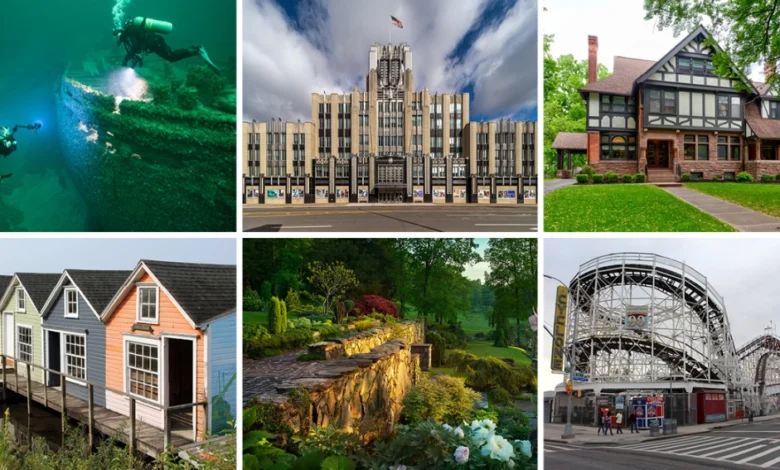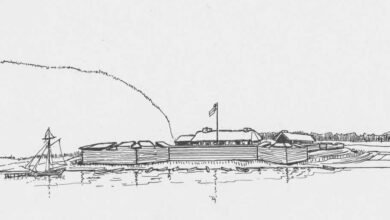Some Unique National Historical Register Listings in New York State


 The New York State Board for Historic Preservation was established in 1972 and expanded by the New York State Historic Preservation Act of 1980. It works with the State Historic Preservation Office to review nominations to the State and National Registers of Historic Places.
The New York State Board for Historic Preservation was established in 1972 and expanded by the New York State Historic Preservation Act of 1980. It works with the State Historic Preservation Office to review nominations to the State and National Registers of Historic Places.
In honor of the milestone 200th meeting of the Board for Historic Preservation (on September 10, 2025), below are some of New York’s most interesting resources in the National Register, either as individual sites or as parts of historic districts.
There are around 130,000 such resources in New York State. These are some of the stand-out, unusual and/or noteworthy New York State listings in the National Register of Historic Places.
The “First” Officially Listed Site: Old Fort Niagara
The National Register of Historic Places was authorized by the National Historic Preservation Act of 1966. Before that, the National Historic Landmarks program provided the primary means for the identification and recognition of significant properties across the nation.

 The National Register of Historic Places built upon this foundation by authorizing a more inclusive means of listing and protecting properties of all levels of significance.
The National Register of Historic Places built upon this foundation by authorizing a more inclusive means of listing and protecting properties of all levels of significance.
All properties designated as National Historic Landmarks before 1966 were automatically listed to the National Register of Historic Places in October of 1966.
New York State had several National Historic Landmarks at that time, including Old Fort Niagara. Built in the 1700s, both the British and the French considered Fort Niagara (now in Youngstown, NY) to be the strategic key to the Great Lakes Basin.
Playing a part in the French and Indian War, the American Revolution, and the War of 1812, the fort was recognized in the National Register as containing the “most complete collection of extant 18th century military architecture in the United States.”
It was designated a National Historic Landmark in 1960 and is now a New York State Historic Site.
Largest Listing: Adirondack Forest Preserve

 The Adirondack Forest Preserve became the first state forest preserve in the United States after concerns about destructive practices by private and commercial interests in New York’s timber lands.
The Adirondack Forest Preserve became the first state forest preserve in the United States after concerns about destructive practices by private and commercial interests in New York’s timber lands.
Landmark legislation in 1885 allowed for the creation of the preserve, stating that the lands were to be forever kept as wilderness. In 1892, the Adirondack Park was formally established, encompassing the preserve lands.
Like Old Fort Niagara, the Adirondack Forest Preserve was first designated a National Historic Landmark (1963). It was added to the National Register in 1966, and it remains the largest (based on acreage) National Register nomination in New York State today.
Smallest: Sidewalk Clock at 200 Fifth Avenue
Sidewalk clocks were once an important part of the street fabric of American cities, serving as advertisements for jewelers and other businesses. The classically-designed Sidewalk Clock at 200 Fifth Avenue in Manhattan was manufactured by Hecla Iron Works and installed in 1909.

 This ornate gilded cast-iron masterpiece is one of six sidewalk clocks listed in the National Register of Historic Places as part of the Sidewalk Clocks of New York City Thematic Resources (1975).
This ornate gilded cast-iron masterpiece is one of six sidewalk clocks listed in the National Register of Historic Places as part of the Sidewalk Clocks of New York City Thematic Resources (1975).
These rare survivors of an earlier era occupy the smallest footprints of any of the resources listed in the National Register in New York State. Interested in exploring the other National Register-listed sidewalk clocks?
They are located at 522 Fifth Avenue, 783 Fifth Avenue, 519 Third Avenue, and 1501 Third Avenue in Manhattan, and 161-11 Jamaica Avenue in Queens.
Largest Historic District: Sunset Park Historic District

 As of summer 2025, New York State’s largest historic district (with nearly 3,500 properties within its boundary) is Sunset Park Historic District in Brooklyn.
As of summer 2025, New York State’s largest historic district (with nearly 3,500 properties within its boundary) is Sunset Park Historic District in Brooklyn.
Listed in 1988, the district encompasses a turn-of-the-century residential neighborhood comprised of large and cohesive groupings of masonry row houses. The neighborhood was rapidly constructed between 1885–1912, with a second wave of development in the 1930s.
Since 1988, the neighborhood has remained the largest historic district in New York State; however, upcoming projects at the New York State Historic Preservation Office are on track to surpass this record.
Nationally Significant Event Related: Space Shuttle Enterprise
The National Register of Historic Places Criteria for Evaluation’s Criterion A related to the resource’s association with events that have made a significant contribution to the broad patterns of our history.

 One of New York’s most unexpected listings in the National Register of Historic Places has to be the Space Shuttle Enterprise, designated in 2013.
One of New York’s most unexpected listings in the National Register of Historic Places has to be the Space Shuttle Enterprise, designated in 2013.
The shuttle is exceptionally significant as the only full-scale prototype of the orbiter fleet used during the early approach and landing tests of the space shuttle program and as the first orbiter to fly in Earth’s atmosphere.
Enterprise was indispensable in proving the flight-worthiness of the space shuttle orbiter and the continued testing and modification of the orbiter fleet throughout the space shuttle program.
While other notable space-related structures from across the country, including launch complexes, NASA buildings, and test facilities, are listed in the Register, Enterprise remains the only shuttle individually listed in the National Register of Historic Places.
Nationally Significant Person: Al Held Home and Studio
The National Register of Historic Places Criteria for Evaluation’s Criterion B relates to the resource’s association with the lives of persons significant in our past.

 The Al Held Home & Studio is the long-time residence (1965-2005) of artist Al Held (1928-2005) in the town of Olive, Ulster County. Held was an innovator in geometric abstraction and an important influence on 21st century abstract painters.
The Al Held Home & Studio is the long-time residence (1965-2005) of artist Al Held (1928-2005) in the town of Olive, Ulster County. Held was an innovator in geometric abstraction and an important influence on 21st century abstract painters.
Held pioneered hard-edge abstraction and was lauded by critics and contemporaries alike. From the beginning of his artistic career, Held had been inspired by the work of prominent public muralists.
The enormous studio spaces in Boiceville allowed him to pursue large-scale work. In a 1989 feature on his Boiceville home and studio in Architectural Digest, critic Deborah Solomon quoted Held affirming its importance to his art-making: “my work is more concentrated here than in Manhattan.”
The residence was listed in the National Register of Historic Places in 2020 and is home to the Al Held Foundation. Entering the studio today, one is filled with wonder at its voluminous space and cathedral-like ceiling.
Nationally Significant Person: Alice Austen House
Pioneering female photographer Alice Austen (1866–1952) grew up in her family’s picturesque home on Staten Island and later lived there with schoolteacher Gertrude Tate, her partner of 55 years.

 Originally listed in the National Register of Historic Places in 1970, the listing for the 1600s house did not reveal the full extent of Austen’s significance as a lesbian artist. Austen’s photography often featured her non-traditional friends, creating a unique group of provocative images of a social life that was out of the ordinary for its time.
Originally listed in the National Register of Historic Places in 1970, the listing for the 1600s house did not reveal the full extent of Austen’s significance as a lesbian artist. Austen’s photography often featured her non-traditional friends, creating a unique group of provocative images of a social life that was out of the ordinary for its time.
Through the efforts of the NYC LGBT Historic Sites Project, the site’s 1970 nomination to the National Register was amended in 2017 to include its significance to LGBT history, proving that nominations can be updated or expanded as new themes and contexts are revealed through additional research.
The additional documentation for the Alice Austen House recognizes Austen’s openly non-traditional life and how she dealt with gender and social norms in her photography.
Nationally Significant Design: Innisfree
The National Register of Historic Places Criteria for Evaluation’s Criterion C relates to resources that embody the distinctive characteristics of a type, period, or method of construction, or that represent the work of a master, or that possess high artistic values, or that represent a significant and distinguishable entity whose components may lack individual distinction.

 Innisfree is a public garden blending Japanese, Chinese, Modern, and ecological design principles in Millbrook, a rural area in the center of Dutchess County.
Innisfree is a public garden blending Japanese, Chinese, Modern, and ecological design principles in Millbrook, a rural area in the center of Dutchess County.
Drawn to the region, Walter and Marion Beck began developing Innisfree as a private estate. Walter, an artist, and Marion, a gardener, were particularly interested in the landscape and created picturesque gardens based on Chinese and Japanese design principles during the early 1930s.
Later, they worked with landscape architect Lester Collins, who helped them design and expand the gardens around their home on Tyrrel Lake. Innisfree became a public garden in 1960 under the leadership of Collins, who then more than doubled the size of the designed landscape.
Today, Innisfree is one of the largest intact modern designed landscapes in America and in 2019 was listed in the National Register as nationally significant for its landscape architecture.
National Significant for Information Potential: Schooner St. Peter
The National Register of Historic Places Criteria for Evaluation’s Criterion D is related to resources that have yielded, or may be likely to yield, information important in prehistory or history.

 Significant to maritime history, the St. Peter shipwreck is listed in the National Register of Historic Places (2004) as a rare and intact Great Lakes bulk cargo schooner.
Significant to maritime history, the St. Peter shipwreck is listed in the National Register of Historic Places (2004) as a rare and intact Great Lakes bulk cargo schooner.
Built in 1873, St. Peter sank in Lake Ontario in 1898. The schooner remains in the lake today and is exceptionally well-preserved in cold, deep water. The wreck retains the lines of a post-Civil War schooner and most of its working hardware, including hatchways, masts, booms, steering components, hoisting equipment, and pumps.
The site represents one of the best-preserved shipwrecks recorded in New York State and in 2024 was nationally recognized as part of the Lake Ontario National Marine Sanctuary designation by the National Oceanic and Atmospheric Administration.
Multiple Property Documentation Listing: Lustron Houses of New York
Built between 1948 and 1950, “Lustron houses” were pre-fabricated houses made of enameled steel panels (inside and out) manufactured by the Lustron Corporation in response to the post-World War II housing crisis.
Less than 3,000 were produced before the company went into bankruptcy. Less than one hundred Lustron homes are estimated to survive in New York State.

 Several of these are listed in the National Register of Historic Places either individually or as part of a historic district (e.g., the Lustron Houses of Jermain Street Historic District in Albany, listed in 2009) under the Lustron Houses of New York Multiple Property Documentation Form (MPDF).
Several of these are listed in the National Register of Historic Places either individually or as part of a historic district (e.g., the Lustron Houses of Jermain Street Historic District in Albany, listed in 2009) under the Lustron Houses of New York Multiple Property Documentation Form (MPDF).
An MPDF is a cover document that serves as a basis for evaluating the National Register eligibility of related properties.
It streamlines the nomination process by providing and organizing information common to the property type(s) and historical themes. The Lustron Houses of New York MPDF (2008) explores the history and design of these unusual (and iconic) post-war structures.
This is the first in a series of essay drawn from the New York State Parks & Recreation Blog which highlight particularly interesting National Register locations in New York State.
Illustrations, from above: Some New York State National Register properties (provided by State Parks); Old Fort Niagara (provided by OFN); Adirondack Forest Preserve (courtesy DEC); Sidewalk Clock at 200 Fifth Avenue in Manhattan (Courtesy Wikipedia user Jim Henderson); Sunset Park Historic District (courtesy NYC Historic District Council); Space Shuttle Enterprise being loaded into Intrepid Air and Space Museum (courtesy Dan Desmet, US Army Corps of Engineers); Al Held Home and Studio (from Sari Ruff photo in the National Register nomination); Alice Austen House (courtesy NYC LGBT History Project, photographer: Amanda Davis); Lake Ontario St Peter Shipwreck (NOAA photo); and Lustron House Westchester Deluxe Model M02 in Eden, Erie County.
Source link




